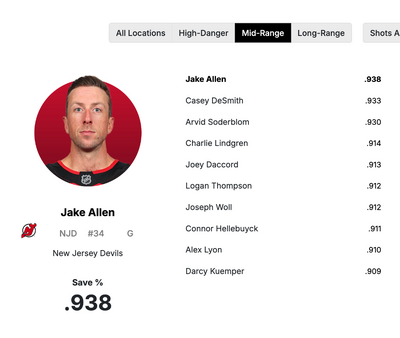-
Posts
31,778 -
Joined
-
Last visited
Content Type
Profiles
Forums
Events
Everything posted by dudacek
-
I totally get what you're saying, but the stat isn't presented that way. They weigh the save percentage equally whether its over 20 games or 60 on NHLedge. You'd have to see if there's some way you could filter it to only include "starting" goalies.
-
Analytically speaking the Sabres best hope might be this: Owen Power career 51.9% Corsi despite playing with a rotating cast of bad partners over his first three NHL seasons Jack Quinn significant drop-off across the board in all three categories after being a positive player in all three over his first two seasons. Mattias Samuelsson, see Jack Quinn Along with Dylan Cozens, these seemed to be the skaters who suffered the most from the coaching change and the players with the most analytical potential to bounce back
-
Analytically speaking, and superficially at 5 on5: Norris for Cozens appears a wash Doan for Peterka a small gain Danforth for Lafferty a small gain Kesselring for Jokiharju a small gain Timmins for Clifton a significant gain It kinda follows the Athletic analytics model: they got incrementally better overall, but not enough to make up the gap needed.
-
Josh Norris is a mediocre forward at best analytically. His numbers have fluctuated over the years, but he was at 48% Corsi, had 45.3% in xG% and a bad 40% in ESGF% last year Justin Danforth is only slightly better: 48% Corsi, had 50.1% in xG% and 44.8% in ESGF% Conor Timmins was good: 52% Corsi, had 51.6% in xG% and 56.5% in ESGF% Zach Jones mediocre: 49% Corsi, had 47% in xG% and 50% in ESGF%
-
Doan and Kesselring ranked 1st and 5th respectively on Utah in terms of Corsi at 58% and 54% They were 7th and 3rd in ESGF% at 53.7% and 56.5% And they ranked 1st and 7th in terms of xG% at 60.6% and 53.3% Neither player was getting the most mportant minutes, but they were clearly winning the battles in the matchups they were seeing.
-
Analytically speaking, the Sabres have dumped 3 of their 6 worst ESGF% players: Lafferty, Clifton and Cozens. Two others in the top 6 — Bryson and Malenstyn — have been pushed down the depth chart. Clifton, Malenstyn, Lafferty and Bryson were also four of their worst five Corsi players and four of their worst 5 xG% players. The most prominent departure, Peterka, actually had a very solid ESGF% of 54.2%. His Corsi was 49% and his xG% just 45.3%. In terms of real goals, when these players were on the ice at ES, the Sabres were outscored: Cozens 46-56 Clifton 41-51 Bryson 27-38 Malenstyn 17-33 Lafferty 11-26 Peterka was on the ice for more goals against than any other forward, but at 82-77 was a + player overall.
-
I think it's broader than that. They've added Norris, Doan and Kesselring and they expect growth from Quinn, Benson and Kulich. They also want to score more on the power play. Combined, they think those factors should at least mitigate things. But I think that's an afterthought in terms of off-season strategy. I think they are almost entirely focused on cutting their goals against significantly and transforming from a -20 team goal-differential team to a +20 team, which almost certainly will earn them a playoff spot.
-
These are the numbers I was referring to earlier: https://moneypuck.com/goalies.htm It's interesting that UPL generally also ranked low in the "above expected" categories, meaning that even with the poor defence factored in, he's not making enough saves.
-
A rank in 30s would just mean you're average. I think the problem is how badly things fell off across the board. He went from slightly above average to very good in most categories last year to below average in everything. I've dug up some actual numbers: 24/25 Games started SV% > .900: 45.5% (Below 50th percentile) 23/24 Games started SV% > .900: 64.7% (90th) 24/25 Save percentage: .887 (Below 50th) 23/24 Save percentage: .910 (70th) 24/25 High danger save percentage: .769 (Below 50th) 23/24 High danger save percentage: .830 (86th) 24/25 Mid-range save percentage: .873 (Below 50th) 23/24 Mid-range save percentage: .893 (52nd) I mean someone could run the actual numbers, but I wouldn't be surprised if he put up his 2023/24 numbers last year, the Sabres are in the playoff mix. Now I recognize that's not all on him, but it's pretty hard to underestimate the impact good goaltending would have on this team. The over/under .900 number is huge. James Reimer had 8 games over .900 down the stretch and just 3 under. Not coincidentally, the Sabres went 1-2 in the unders and 7-1 in the overs.
-
Your answer is Sam Reinhart. NHL teams in general sign players to deals like this with the assumption the player will be overpaid at the start of the contract and underpaid at the end of the contract as they develop. The Sabres in particular also have to deal with the issue of attracting/retaining talent as one of the league’s less attractive markets and are more sensitive to the realities of “a bird in the hand is worth two in the bush” than, say, Vegas. Those are your big picture contextual answers. As to Power himself the tools and the pedigree are obvious; it’s also pretty clear after two years of watching him train, practice and interact that they regarded the person as someone they are comfortable investing in long-term. When they signed him Power was coming off his second season with these statistics: ES points 26 icetime 1880 Corsi 52% GF% 53% xGF% 47.2% These are Power’s peers at the time of signing their second contracts. Luke Hughes ES points 28 icetime 1506 Corsi 56% GF% 52.8% xGF% 55% Jake Sanderson ES points 15 Icetime 1687 Corsi 50% GF% 47.5% xGF% 49.2% Moritz Seider ES points 24 Ice time 1833 Corsi 45% GF% 48.6% xGF% 42.7% Rasmus Dahlin (bubble season) ES points 12 Ice time 1211 Corsi 55% GF% 43.6% xGF% 50.7% Seider $8.5m and Sanderson $8m signed similar deals to his. We’ll see what Hughes gets soon. Dahlin signed a bridge for $6M which (with inflation) represents roughly what would have been the alternative to what Power signed. I’d also point to the deals signed by the likes of Miller and Provorov this summer under the growing cap as a sign of things to come and a warning of how $8M is not going to be what it was, very soon. None of that changes the fact that Power regressed in the 1st year of his 2nd contract while his peers continued to develop. We’ll see if that is a blip, or whether he bucks the trend and fails to emerge the way most players of his pedigree tend to, and the way he was on track to in his first 2 seasons. Bringing it back to Reinhart. There's an example of a high-pedigree guy who wasn't an immediate star and the Sabres did not lock up. Fear of repeating that mistake has to be a motivator. Your question was what did they see in him. There’s an answer. The contract still has 6 years to prove its worth.
-
NHL.com breaks goalie save percentages down into three categories. Too lazy to look up the numbers again, but my memory is telling me UPL ranked in the 30s among 60ish NHL goalies in sv% the “easier” situations and nearly at the bottom in the toughest situations.
-
I don’t think so. I don’t see a team where the D are making a lot of bad offence-first choices and giving up a ton of chances as a consequence. I saw (in particular) Clifton, Power and Samuelsson making a lot of poor zone coverage decisions and execution. And I saw forwards (especially Quinn and Cozens) too often making a lot of bad puck decisions that flipped the ice the other way.
-
The numbers say UPL is demonstrably better in low and medium chance situations than in high danger ones.
-
I think one of the reasons the Sbres offence has been as effective as it has is the amount they generate from the blueline. This team has three of the top 20 even strength scoring defencemen in the league and Kesselring added another player in the top 50. Owen power was 3rd on the Sabres, but would have been 1st on 19 teams. The Sabres top 4 D accounted for 141 points last year. Colorado led the league with 132. Forwards generally find is easier to score with that kind of support from the blueline and I suspect it will help the new arrivals.
-
It seems like you did. Basically I'm just comparing the 2023 team with the guy who took his roster spot and/or role. Incrementally, we got harder in most positions. it's not much on a player for player level, but across half a team its significant. (incidentally, I neglected Benson. Asplund and or Hinostroza were the next two for the 23 team in terms of games played)
-
Soft is an overused word and one that rests on a spectrum. In terms of that spectrum, which of these players do you consider harder? Cozens Norris Mittlestadt McLeod Peterka Doan Skinner Zucker Olofsson Kulich Okposo Greenway Girgensons Malenstyn Jost Danforth Jokiharju Byram Lyubushkin Kesselring Bryson Timmons As much as people complain Adams hasn’t made changes, this is not the same Sabres team it was.
-
There’s a lot of upward mobility potential on the forward ranks. Krebs is not near the top of that list and I would be very surprised if he took a step. But I am probably in the minority here in that haven’t given up on the likelihood of a handful of the youngsters being better.
-
I’m going to throw an unlikely bone into the centre ice stew. McLeod entered last year coming off a career-high 30 points in 81 games at 25 in his 3rd full NHL season. Nobody expected what he did. Peyton Krebs is coming off a career-high 28 points in 81 games at 24 in his 3rd full NHL season. 😘
-
Thanks for posting. Goaltending is far and away the number one question mark for me although I believe it is tied to reducing the excess of Grade A chances. We’ve hashed the JJP numbers pretty thoroughly; not seeing ES scoring as an issue with this roster and the PP already sucked with him. The McLeod thing is an interesting take. Most of us agree Norris and Kulich come with question marks. We’ve kinda accepted McLeod might slip but he’s still a good 3. The idea that he could take another step is not one that I’ve seen get any traction. But really, is a 60-point McLeod any harder to foresee than a 60-point Norris or Kulich?
-
Devon Levi signed to a 2 year 812k contract extension
dudacek replied to Brawndo's topic in The Aud Club
Probably the trade off for the one-way deal. -
In the case of Kulich, players do not typically take a big jump after 60ish games. Its a big reason why I’ve been preaching caution with him. Not saying it can’t happen, but it’s not typical






